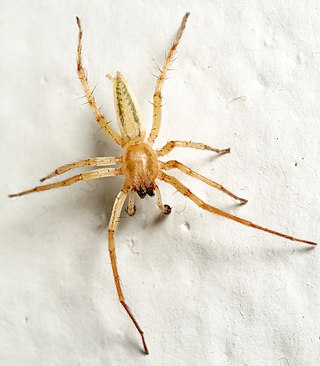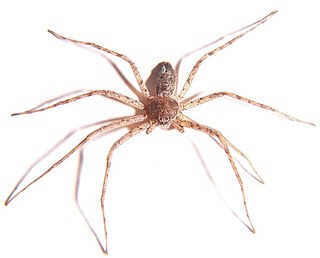
The Thomisidae are a family of spiders, including about 170 genera and over 2,100 species. The common name crab spider is often linked to species in this family, but is also applied loosely to many other families of spiders. Many members of this family are also known as flower spiders or flower crab spiders.

Huntsman spiders, members of the family Sparassidae, are known by this name because of their speed and mode of hunting. They are also called giant crab spiders because of their size and appearance. Larger species sometimes are referred to as wood spiders, because of their preference for woody places. In southern Africa the genus Palystes are known as rain spiders or lizard-eating spiders. Commonly, they are confused with baboon spiders from the Mygalomorphae infraorder, which are not closely related.

Nursery web spiders (Pisauridae) is a family of araneomorph spiders first described by Eugène Simon in 1890. They resemble wolf spiders (Lycosidae) except for several key differences. Wolf spiders have two very prominent eyes in addition to the other six, while a nursery web spider's eyes are all about the same size. Additionally, female nursery web spiders carry their egg sacs with their jaws and pedipalps instead of attaching them to their spinnerets as wolf spiders do. When the eggs are about to hatch, a female spider builds a nursery "tent", places her egg sac inside, and stands guard outside, hence the family's common name. Like the wolf spiders, however, the nursery web spiders are roaming hunters that don't use webs for catching prey.

Theridiidae, also known as the tangle-web spiders, cobweb spiders and comb-footed spiders, is a large family of araneomorph spiders first described by Carl Jakob Sundevall in 1833. This diverse, globally distributed family includes over 3,000 species in 124 genera, and is the most common arthropod found in human dwellings throughout the world.

Anyphaenidae is a family of araneomorph spiders, sometimes called anyphaenid sac spiders. They are distinguished from the sac spiders of the family Clubionidae and other spiders by having the abdominal spiracle placed one third to one half of the way anterior to the spinnerets toward the epigastric furrow on the underside of the abdomen. In most spiders the spiracle is just anterior to the spinnerets. Like clubionids, anyphaenids have eight eyes arranged in two rows, conical anterior spinnerets and are wandering predators that build silken retreats, or sacs, usually on plant terminals, between leaves, under bark or under rocks. There are more than 600 species in over 50 genera worldwide.

Philodromidae, also known as philodromid crab spiders and running crab spiders, is a family of araneomorph spiders first described by Tord Tamerlan Teodor Thorell in 1870. It contains over 500 species in thirty genera.

Orb-weaver spiders are members of the spider family Araneidae. They are the most common group of builders of spiral wheel-shaped webs often found in gardens, fields, and forests. The English word "orb" can mean "circular", hence the English name of the group. Araneids have eight similar eyes, hairy or spiny legs, and no stridulating organs.

Linyphiidae, spiders commonly known as sheet weavers, or money spiders is a family of very small spiders comprising 4706 described species in 620 genera worldwide. This makes Linyphiidae the second largest family of spiders after the Salticidae. The family is poorly understood due to their small body size and wide distribution; new genera and species are still being discovered throughout the world. The newest such genus is Himalafurca from Nepal, formally described in April 2021 by Tanasevitch. Since it is so difficult to identify such tiny spiders, there are regular changes in taxonomy as species are combined or divided.

Ant spiders are members of the family Zodariidae. They are small to medium-sized eight-eyed spiders found in all tropical and subtropical regions of South America, Africa, Madagascar, Australia-New Guinea, New Zealand, Arabia and the Indian subcontinent. Most species are daytime hunters and live together with ants, mimicking their behavior and sometimes even their chemical traits. Although little is known about most zodariids, members of the genus Zodarion apparently feed only on ants; a number of other genera in the family are apparently also ant specialists.

Dictynidae is a family of cribellate, hackled band-producing spiders first described by Octavius Pickard-Cambridge in 1871. Most build irregular webs on or near the ground, creating a tangle of silken fibers among several branches or stems of one plant.

Cybaeidae is a family of spiders first described by Nathan Banks in 1892. The diving bell spider or water spider Argyroneta aquatica was previously included in this family, but is now in the family Dictynidae.

Dwarf tarantulas, also known as sheet funnel-web spiders are a type of spider from the family Mecicobothriidae. Dwarf tarantulas are one of several families of the suborder Mygalomorphae; this larger group also includes the true tarantulas.

Stenochilidae is a family of southeast Asian araneomorph spiders that produce ecribellate silk. First described by Tamerlan Thorell in 1873, it now contains twelve described species in two genera.

Mecysmaucheniidae is a family of araneomorph spiders first described by Eugène Simon in 1895. Most genera occur in South America, with two genera endemic to New Zealand.

Argyrodes, also called dewdrop spiders, is a genus of comb-footed spiders that was first described by Eugène Louis Simon in 1864. They occur worldwide, and are best known for their kleptoparasitism. They can spin their own webs, but tend to invade and reside in their hosts' webs. This relationship can be commensal or even mutual if the dewdrop spider feeds on small trapped insects that are not eaten by the host. Some species can even prey upon the host.
Stenochilus is a genus of Asian araneomorph spiders in the Stenochilidae family, and was first described by Octavius Pickard-Cambridge in 1871. As of September 2019 it contains three species, found in Asia: S. crocatus, S. hobsoni, and S. scutulatus. It is considered a senior synonym of Metronax
Stenochilus hobsoni is a species of spiders in the genus Stenochilus.
Stenochilus scutulatus is a species of spider in the genus Stenochilus.














